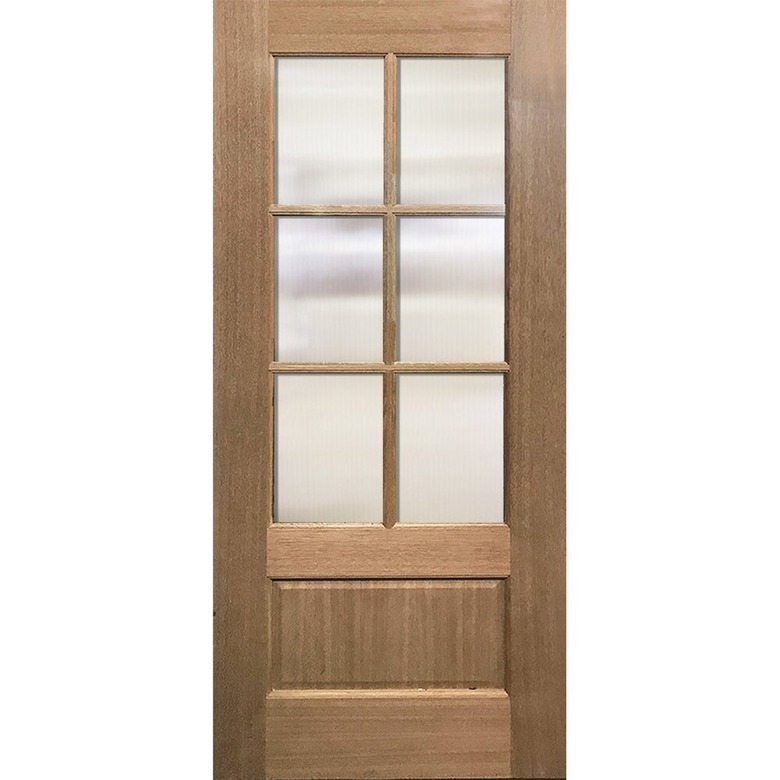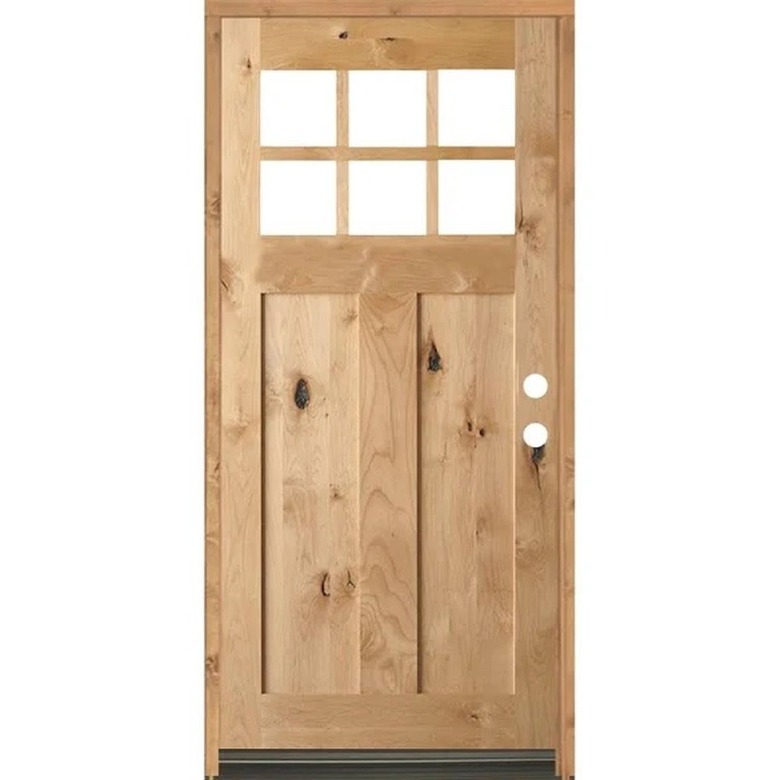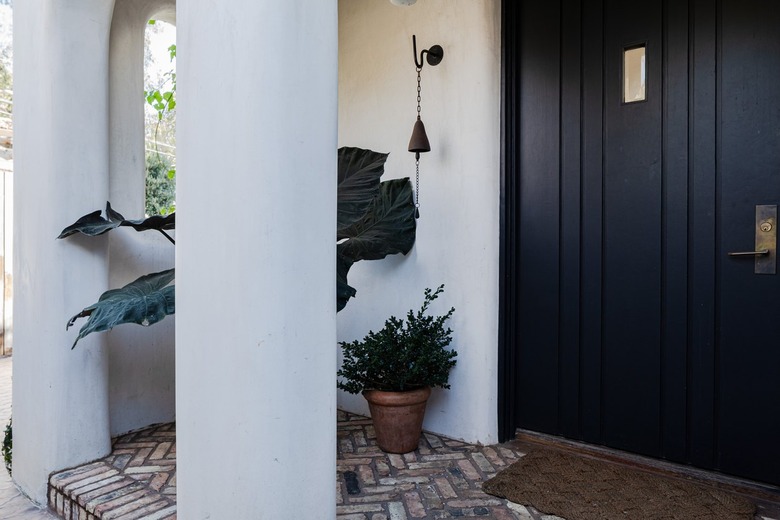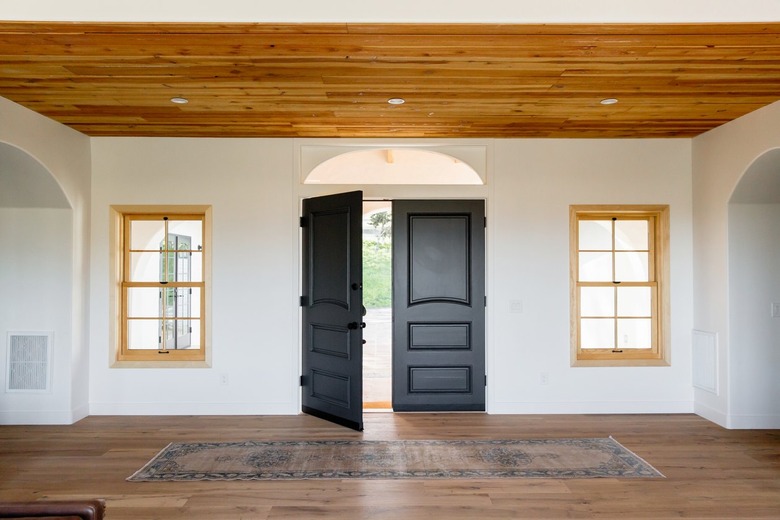Pre-Hung Vs. Slab Doors: What Are The Differences, And How Do You Choose?
A functional door requires multiple parts to work, including the door itself, the frame, the hinges, and the doorknob (or handleset). When you're purchasing a new door for your home, you'll need to decide if you want to buy a door that is sold on its own (known as a slab door) or a door that is sold in a complete package with everything but a doorknob and possibly a deadbolt (this is known as a pre-hung door). Generally, if you're replacing an exterior door or performing new construction, you'll want a pre-hung door. If you are replacing an interior door and are working with an undamaged door frame, a slab door is typically the better option.
Tip
A slab door is an unprepared door with no holes for the doorknob, whereas a pre-hung door is a door that comes installed in the frame complete with hinges and a hole for the knob.
What Is a Slab Door?
What Is a Slab Door?
A door slab is a large rectangle made of wood, metal, fiberglass, or acrylic that fits within the door jamb and swings open or closed. When you buy a slab door, it will be sold with no hinges and no door frame. One or more holes may or may not be cut out to accommodate the doorknob. If there is no hole, you or your installer will need to drill your own hole. If there is a hole and you are installing the door in an existing frame, ensure the doorknob hole is at the same height as the mortise hole in the door jamb (aka an etched pocket that's created to fit the door latch).
Because you're working with just a bare bones door that still needs several things (like a door knob and a mortise) to make it functional, installation is much trickier than with a pre-hung door. In order to install a slab door, you need to remove the hinge pins to take off the old door and use it as a guide for the new slab, making marks to indicate how much the door should be trimmed to fit the opening and where the hinge mortises and knob holes need to be cut.
Next, you will need to carefully cut out the mortises using a router or a chisel and hammer and then cut the knob holes. You'll then want to install the hinge on the slab and use shims to lift the door to the appropriate height before using the hinge pins to secure the door back on the frame. After testing the door to ensure it opens and closes well, you'll need to install the doorknobs and run a final test to make sure it latches properly. All in all, this installation process is best suited for an advanced DIYer who is comfortable with power tools and construction basics.
What Is a Pre-Hung Door?
What Is a Pre-Hung Door?
A pre-hung door is a self-contained door assembly that features a door slab secured with hinges to a complete door frame. The door will have a pre-drilled hole to accommodate the doorknob, and the frame will have one or more corresponding mortises drilled into it for the latch. Those designed as exterior doors typically also feature a threshold, a hole for a deadbolt, and weatherstripping. The only parts you need to purchase separately for a pre-hung door will be the doorknob and, for an exterior door, a deadbolt.
Installing a pre-hung door requires more work up front but can be a lot less frustrating since it doesn't require the expertise and care necessary to cut hinge mortises or doorknob holes, nor does it require shims to hold the door in place while you insert the hinge pins. On the other hand, prior to installing a pre-hung door, you will need to remove the casings on the existing door, cut through the nails holding the existing frame, and then fully remove the full frame and door. Installation may also be more complicated when installing an exterior door over brick molding since the siding must butt up against the trim.
Considerations When Purchasing a Door
Considerations When Purchasing a Door
Now that you understand the differences between a slab and a pre-hung door, how do you determine which one is the right one for your home? It largely comes down to how much customization you want.
For example, because the holes for the knobs or handles are already pre-drilled on a pre-hung door, not all types of handles or deadbolts are compatible with all types of pre-hung doors. Before purchasing, make sure your chosen hardware will match your choice of pre-hung door. This is one major advantage of purchasing a slab door: Because there aren't any pre-drilled holes you are free to choose whatever hardware you like best.
Another thing to keep in mind before purchasing is the direction of the door swing. Always be sure to order a pre-hung door that will swing open in the proper direction for your specific room. Likewise, a slab door with a pre-drilled hole must have the same swing orientation as the original door. This is because the latch edge of most doors has a slight bevel designed to minimize the gap between the closed door and the door frame. When a slab has no pre-drilled hole, you can position the door to work for either right swing or left swing. Then, you drill and cut for the handle assembly and the hinges.
It's also worth remembering that many designs are unavailable as pre-hung doors. Generally, custom doors, doors made from reclaimed materials, and other specialty doors must be purchased as a slab since pre-hung doors are mass manufactured. Though pre-hung doors are easily found in big box home improvement stores or in online home stores like Wayfair or Overstock, you can also search in local architectural salvage shops for vintage doors for a one-of-a-kind look.
And, like any other home improvement project, cost is a big consideration. Slab doors start at about $50 for a basic hollow-core or MDF interior door. An interior solid wood or composite primed door runs around $300, and a natural solid wood door (in alder or pine, for example) costs about $500. But, keep in mind that if you order a slab door and you don't consider yourself a DIY pro, you may need to also factor in the cost of professional installation.
Which Is Better for Exterior Doors: Pre-Hung or Slab?
Which Is Better for Exterior Doors: Pre-Hung or Slab?
When it comes to exterior doors, installing a pre-hung door is almost always better (and easier) than installing a slab door. This is because the slab must stay weather-tight when shut to keep the home properly insulated and protected from unwanted insects and other pests. Since exterior pre-hung doors are usually fitted tightly between the frame and threshold and feature weatherstripping, these are usually the best option for exterior doors, particularly for those who plan to DIY the project.
If you're hiring a professional, most contractors will be experienced enough to install a pre-hung door, but if you are looking for the increased design flexibility offered from a slab door, be sure to work with an experienced carpenter because getting a proper hang and seal can be very difficult. This job will typically require a door frame to be built from scratch, particularly if the door is a custom size, recycled, or made from a reclaimed material.
Which Is Better for Interior Doors: Pre-Hung or Slab?
Which Is Better for Interior Doors: Pre-Hung or Slab?
Whereas pre-hung doors are almost always preferable for exterior doors, things aren't so cut and dried when it comes to interior door installation. Installing a slab door could actually save you money and allow you more design flexibility, but this is only advisable if the existing door frame is in good condition, since a damaged door frame will continue to deteriorate and cause further problems even with a new slab installed.
If you plan to use the existing door frame when installing a slab door, you must buy a new door the same width as the old one and then trim a little off the bottom to adjust the height. However, if you're using a recycled or vintage door you are better off hiring a professional experienced in carpentry to install it (even if the door size matches the frame). These types of doors are typically more difficult to install since they are often warped, heavy, or may require the existing hinge mortises and doorknob holes to be filled and repainted before new mortises and knob holes are cut.
If you want to change the size of the doorway or if the frame is damaged and needs to be removed, replacing the frame with a pre-hung door is much easier and faster than installing a slab door. Also, while slab doors are typically cheaper than pre-hung doors, hiring a professional to build a new frame and install the slab and frame will often cost more than hiring someone to install a pre-hung door.
All in all, unless you're looking for a particular design aesthetic that can only be achieved with a custom or vintage door, you're typically better off using a pre-hung door when you need to also replace the frame.
What About New Construction?
What About New Construction?
When it comes to new construction of both interior and exterior doors, pre-hung doors are typically the preferred option because they are so much easier to install. Those seeking a unique appearance may still choose to use a custom or vintage slab door, though it will typically need to be installed by an experienced professional since you must also have a custom frame to match.



